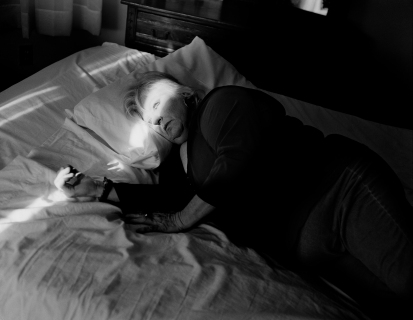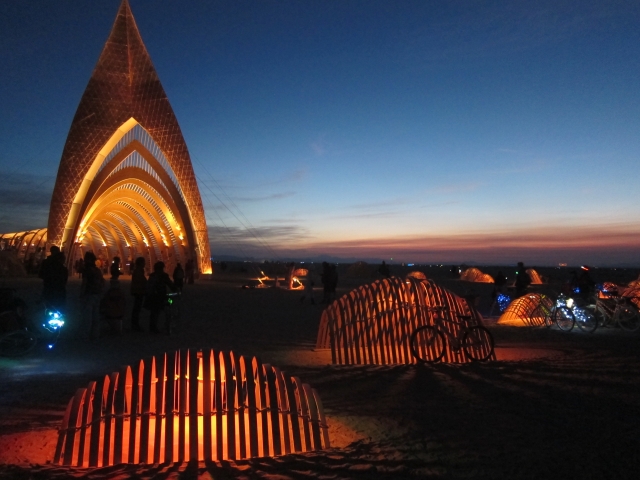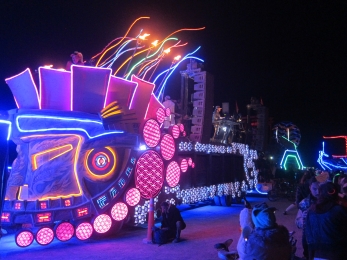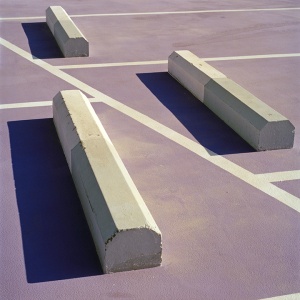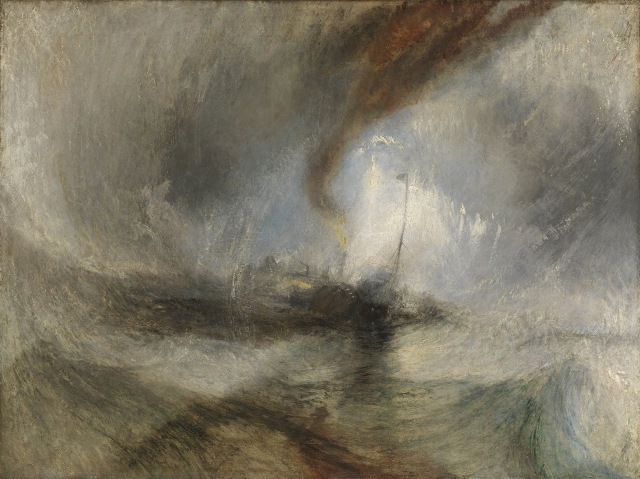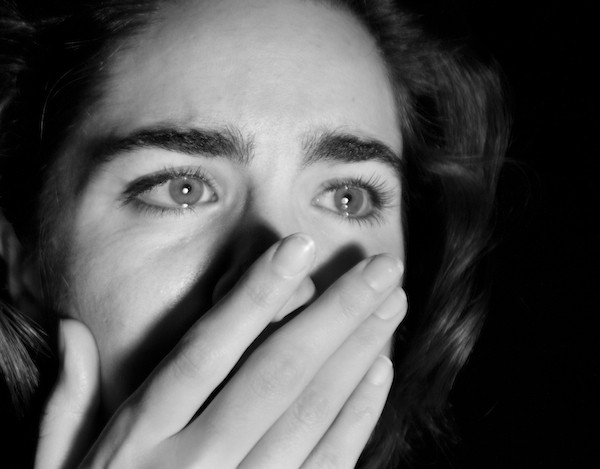
#10967-2498 © Todd Hido 2012
A woman clasps her hand to her mouth. Visible in her eyes could be fear, horror, grief, or even just acute worry.
The image described is not the one above, but one similar sent to me by a friend, who in the Spring of 2012 was assistant to photographer Todd Hido. Hido was working on a shot for which he felt he needed an actress and my friend knew I had theatre training. I stared at the example image, intrigued, flattered, and not a little curious.
Hido is one of the biggest names in photography today. There are two best-known branches of his oeuvre, one involving suburban houses and landscapes, and the other, women.
There is a strange opposition in Hido’s vision. His unpeopled scenes are gravid with unarticulated emotion and withheld answers to unformed questions — houses with their interior lights shining almost too-brightly in the night, grimly beautiful barren landscapes shot through sun-spotted windshields, fog hanging heavy like a psychic pestilence. Suburbia was never as innocent as we told ourselves. He imbues these familiar subjects with a low-flame drama that makes you suspect you’ve never noticed their quiet, sad, and sometimes threatening beauty or perceived their fugitive secrets.

#10845-7 © Todd Hido 2012
Hido’s photographs of women — well, I had been more ambivalent about them. Where he finds an unexpected richness in the familiar when photographing inanimate objects, he rehashes regrettable and outmoded cultural cliches when he trains his lens on human beings.
Women slouch on seedy bedspreads or lie slumped in the backseat of a car, sucking a liquor bottle. They’re most often represented in their underwear or fully nude, although occasional nods to other eras appear in vintage costuming and coiffure. They stare through glazed eyes over cheeks stained with mascara tears, or cower in ripped stockings as some unseen menace approaches. Some of the characters appear drugged. These women seem like passive bit players in other people’s dramas, their main function is sexual, they’re victims of their own, if not someone else’s, bad decisions.
The drama in Hido’s photos of women is still there, but its nature is not quite so unusual or revelatory as that in his images of houses or trees. We are all unfortunately habituated to seeing women portrayed in this way. Hido tends to sequence his photographs as part of larger projects like exhibits and books. What gets a reluctant pass upon assessing the images individually, is more troubling when examining them as a group. It’s hard not to wonder why women occupy such limited roles in his imagined dramas. The repetitive tokenism of Casting Call Woe comes to mind.

Untitled #10474-a © Todd Hido, 2011.
BUT THIS SEEMED DIFFERENT
For my modeling session, I would not be asked to take my clothes off. I was invited to invest a character with more, or at least a different kind of, humanity usually conveyed by “Hido girls.” My sexuality would be left ambiguous and there would be nothing suggesting I was or wasn’t a victim. The drama would be in my face and whatever I was able to project through my eyes, not the situation my body was shown in, what carpet shag I was sprawled out on or what kind of underwear or runny tights I was wearing. As far as I could tell, this image could represent an intriguing departure for Hido, and I was curious to see what he would do. For sure, art history (and literary history, and music history, and history) is full of men comprehending and depicting women within similarly narrow parameters to Hido’s. But an artist with talent can evolve.
My portrait was to be a part of a project called Silver Meadows. Hido exhibited “Excerpts from Silver Meadows,” an early incarnation of the series, at Wirtz Gallery in 2012. I had actually reviewed the show (by the way, I am an art critic), extrapolating on my unease with his portrayals of women. In a magnificently awkward coincidence, the article went live the day I was scheduled to model. If he was irked by the review when it appeared that morning, by evening, when we were to meet, he seemed to have forgiven me, and was receptive to the notion that my criticism was valid.
For convenience, Hido, his assistant and I met at a gallery opening. We grabbed takeout from Tu Lan, and on the drive to his Oakland home and studio chatted about TV shows and Obama’s rendition of “Let’s Stay Together.” Over spring rolls and beef salad we talked about whether it was possible to portray a woman in the sort of fraught situations he imagined, but in a way that still afforded her some power, and some agency. I knew it was possible; I had spent too much time studying Ibsen, Williams, even Sarah Kane, for it to be a question. But it seemed like a new concept to Hido — or the notion that his photographs did not suggest that a woman could be seen this way seemed like a new concept to him. Could a frightened woman still be powerful? Could she be sexual without being a sex object in a scenario rendered by a male artist?
Hido suggested that in this and future shoots we could experiment with this different kind of portrayal of women, one in which she existed in his famously sinister, lurid, carnal world but with an inner will pushing back against passivity, complicating her character into something more than victim or vamp. While I was excited to witness and possibly participate in what might be an expansion of his work, I wondered why the idea was new to him, why no one in his network of friends and supporters had broached the topic to him before. It was not a new or obscure idea, and I knew from many conversations I had had with others that my reaction to his work was not unique, though as far as I knew, I was the only one who had said anything publicly. He was thoughtful, even humble, and it seemed my review had troubled his mind but hadn’t offended his ego. He spoke with both me and his assistant as equals, and by the time we were finished with our meal I was relaxed and excited to work.
IN THE STUDIO
I’ve been a performer of one kind or another most of my life, and know well that the scrutiny of an audience, that army of eyes in the dark, can draw strange new inner personae to life and move you to give over more than you knew you had. But the weight of an artist’s stare is something different, freighted with bigger, heavier, more unknowable expectations than those of a passive audience. He means to create something out of the material that is you, your physical appearance as well as the visible manifestations of your thoughts and the feelings that emerge, sometimes unbidden, under his direction. It’s hard not to suspect that the artist is searching your visage for something you will surely fail to give him, and that he is nevertheless finding more than you ever meant to disclose. It’s rather like the gaze of someone who thinks they are in love with you but who in fact doesn’t know you very well at all: for them you are an amalgam of projections and desires, and the intensity of their stare will yield something false and foreign — but weirdly intimate all the same, and possibly a beautiful creation in its own right, however forced, and however much unlike you it is in the end. Modeling feels like not so much a performance as a sort of painless vivisection.
He told me where to look, where to place my hand, and switched cameras, many of which looked to me like toys, numerous times. His assistant rapidly changed lenses and film and manipulated the hot white light. It was an impeccably choreographed display of efficiency between the two of them, so practiced and finessed that they could frequently make hilarious jokes at each other without missing a beat. I appreciated their levity and humor, as the whir of activity, the attention, the streamlined unrelenting professionalism of their process was bearing down on me in a way I found difficult to justify. I hadn’t even taken off my coat, and my hand was covering half my face, but I felt exposed to a degree I hadn’t anticipated, like a small naked child waking up in a room full of adults speaking a foreign language. Hido’s directions were banal and unobtrusive: “Look up.” “Think of something terrible.”
Nothing inappropriate was done or said throughout the sitting. That I felt like Hido was plumbing my inner life was due entirely to, as Alexander Nemerov puts it, the photographers’ fanatical quality of attention, and I emerged from the shoot with a new respect for anyone who doesn’t wilt under it.
The resulting portrait seemed to satisfy Hido’s hopes for what it would be, and I was up for continuing our exploration of the more complex and counterintuitive ways he might portray the women populating his artistic imagination. But we never did schedule another sitting.

#10967-2498 © Todd Hido 2012
The photograph of me was used as the penultimate image in the book Silver Meadows (Nazraeli Press, 2013) in which, with the exception of this one portrait, everything I had originally objected to in his portrayals of women was repeated and even exaggerated. I reviewed the book in a manner that probably shut the door on any future collaborations.
A NEW DIRECTION
I recently went to Paris Photo LA and saw the exhibit Selections from a Survey, a series by Hido, combining new and old work, focusing on his primary model, a blonde chameleon named Khrystyna. I don’t know if the concept for the show was Hido’s or that of his new Bay Area gallerists Casemore/Kirkeby. Whoever is owed credit, the show is an example of the power of curation.
Hido’s preoccupations have not changed. Khrystyna appeared in various wigs and states of dress and undress, sensuously inviting, sexually prone, crying, pouting, cowering, apparently frightened of or tearfully recovering from some violence wrought by an unseen antagonist. Adding to the menacing atmosphere in which she lived were malevolently glowing interiors, Poltergeist televisions, landscapes of glowering skies and roads perilously slickened with rain, as well as additional found photographs of hulking footballers and wrecked cars. But it’s the fact that one followed just one woman through these scenes and incarnations that made a big difference. In other series of Hido’s, many women appear in these contexts, their number and similar roles implying interchangeability and reducing them to anonymity — footnotes and pattern-fillers in a man’s drama.
Cached in a tiny fake storefront occupied by the gallery on the fair’s Paramount Studios backlot, Selections was more like a character study of Hido’s subject: an impetuous, bewildered, and reactive tragic heroine, magnetic but doomed, blessed and abandoned by Luck. Though the series was conceived by Hido, the drama belonged to Khrystyna and hers was the world into which gallery-goers were immersed. It doesn’t matter that Selections’ scenes were “drawn from Hido’s own biography” and “imperfect memory” as the press release states; it was, in fact, curiosity toward Khrystyna’s psyche and experience that came to dominate. In a break from his usual practice of using women as one-dimensional extras and walk-ons, Hido made this one the “star” and managed to preserve her humanity.
I wouldn’t presume to have had any influence on Hido’s work, but it seems it is changing, slowly. I’m glad I had the experience of existing in front of his lens, and I’m happy to cede the modeling field to those who, like the “shape-shifter” Khrystyna, aren’t catapulted into psychic apoplexy by it. I remain curious to observe where Hido’s art goes, what the next focus will be, whether he will discover any new and unorthodox women populating his imperfect memory.
This article originally appeared in Vantage.



